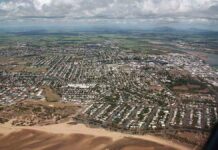Howdy American cousins, we hear ya’ll are thinking of moving to Australia. Or, in local lingo, mate, you gunna come live in Oz, sweet as cuz. It’s both simple and difficult for Americans to move to Australia, our immigration system is a bit different to yours and there’s no set “green card”. Most immigrants complain that our system is overly complicated, so we’ve given you the “Cliff’s Notes” below. Moving to Australia from the United States is both easier and more difficult than other countries. New Zealand immigration to Australia is relatively simple, but moving here from a lot of our close Asian neighbours can be a paperwork nightmare. Plus, we’re here to tell you, Americans moving to Australia, will love Queensland. It’s our Florida, without all the crazy new stories… wait, no, we have those too.
Why Australia, and where in Australia?
If you long for a high standard of living, excellent health care and a strong education system where children can feel safe, you may be considering moving to Australia. While each of Australia’s states has something different to offer, Queensland has everything from lush rainforests, tropical islands, relaxed coastal towns, and stunning beaches, to bustling cities and the remote outback.
Much like Florida, Queensland is known colloquiality as ‘the sunshine state’ but has much to offer besides good weather. Boasting a well-developed transport system and an abundance of natural resources, Queensland also has a diverse population, making it a perfect fit for migrants. So, if a sub-tropical climate where the sun shines over 300 days a year appeals to you, and you like outdoor living, jaw-dropping scenery, and friendly locals, we think you’ll love Queensland. Queensland also offers a plethora of regional/remote jobs, which can “beef up your Australian visa” application.
You’ll be spoiled for choice when deciding where to live in Queensland. Whether you opt for rural, city, outback, beach or island life, Queensland is still comparatively more affordable than the other migrant hotspots such as Melbourne and Sydney.
How to Move to Australia
Before you pack a suitcase and jump on a plane bound for your new life in paradise, there are a few hoops you’ll have to jump through first. The good news is that if you are an American citizen who meets Australian health and character requirements, you can apply for a visa to move to Australia from the US. There are a number of subclasses of Australian visas, such as work visas, holiday visas, family visas, and student visas, so you must select the one that applies to your personal situation.
Permanent migration to Australia is highly regulated. Of the 190,000 permanent visas that are granted each year, most of them are for skilled migration, demonstrating Australia’s commitment to welcoming migrants who can boost the economy and have a positive impact.
So, the first step in relocating to Australia, is to get a permanent visa.
Australian Visa Points System
Unless you already have work lined up in Australia and can get an Employer Sponsored Visa, you’ll need to obtain an Independent Skills Visa.
Firstly, you’ll need to lodge an expression of interest through an online system called SkillSelect, which ranks applicants based on a range of personal information. To move forward in the process, applicants need to have skills that match the Skilled Occupations List and reach a certain number of points.
Visit the Immigration Points Calculator online.
The Australian Visa Points System awards points for various factors that are deemed important for the economy. Factors that are considered include;
Age requirements for Australian visas
Applicants are given a score based on their age.
- 18-24 years old = 25 points
- 25-32 years old = 30 points
- 33-39 years old = 25 points
- 40-44 years old = 15 points
- 45-49 years old = 0 points
English Proficiency
Applicants from native English-speaking countries like the US and the UK do not have to take an English language test. Also, those who have completed a degree in a predominantly English-speaking University, that is equivalent to or higher than an Australian bachelor’s degree (college degree), do not have to sit the test.
Employment Experience
To gain points for skilled work experience it must be related to a role on the Skilled Occupations List. Currently, there are also “skills shortage” visas available, these may or may not offer a path to permanent residency but will get your foot in the Aussie door.
Length of skilled employment within Australia:
- 8 years = 20 points
- 5 years = 15 points
- 3 years = 10 points
- 1 year = 5 points
Length of skilled employment outside of Australia:
- 8 years = 15 points
- 5 years = 10 points
- 3 years = 5 points
Educational Qualifications
Points can be awarded according to qualifications you have obtained. However, if you have more than one, only the highest one will be considered.
- Doctorate = 20 points
- Bachelor’s or master’s degree = 10 points
- Diploma = 5 points
To receive the points, the Australian government must recognise the qualification as comparable to Australian qualifications. It may be worthwhile considering a Recognition of Prior Learning Assessment, which we will discuss in more detail later. For most US citizens, this isn’t usually too much of an issue. This general impacts immigrants from countries where tertiary qualifications are not globally recognised.
Community Language Qualifications
If you have translator or interpreter skills in one of Australia’s designated community languages, you may be eligible for an additional 5 points.
Skills of Your Partner or Spouse
To be eligible to be awarded additional points for the skills of your spouse or de facto partner, they must be an applicant for this visa and meet the age, English and skill criteria.
If you are successful, SkillSelect will invite you to apply for a permanent visa.
How to Fast Track Your Visa
How long your visa takes to process can depend on several factors, but there are few things that you can do to ensure that you don’t encounter any unnecessary delays.
- Ensure all information on your application is true and correct.
- Ensure your application is complete and includes all necessary supporting documents.
- Respond promptly to any requests for additional information.
Tip: Consider undergoing a Recognition of Prior Learning (RPL) Assessment so that your work skills and prior work experience are recognised in Australia.
What is an RPL Assessment?
An RPL Assessment process assesses your competency acquired through formal learning and work experience. Choose a 100% fully accredited Australian Registered Training Organisation (RTO) that is legally authorised to conduct your RPL assessment and provide you with an RPL qualification that is recognised Australia-wide. One of the issues raised in a recent investigation into the Australian visa-issuing process was poor services and standards for immigrants seeking education-based provisions to visas. Choose your RTO well and make sure they’re fully registered and in good standing.
By completing an RPL assessment you can turn your skills, previous qualifications, life, and work experiences into real Australian qualifications under the Australian Qualifications Framework. This may positively affect your skilled work visa application as well as provide you with greater job opportunities, a better income and accelerated career prospects when you do arrive Down Under!
How Does RPL Work in Australia
In order to convert your experience into nationally recognised qualifications, you can use a variety of documentation in your RPL assessment, such as:
- records of completed training.
- assessment records
- declarations from your employer, and/or
- a copy of your student records
Gaining a Recognition of Prior Learning means that you don’t have to study what you already know. Instead, the RPL assessment allows you to provide workplace examples that demonstrate that you already have the knowledge and skills that studying the qualification would give you. Both paid and voluntary work in Australia and overseas can be used as examples in the RPL assessment.
How Do You Turn Your Current Career into a Recognised Qualification Under Australian Law
If you have worked your way up in your career but are concerned that your education doesn’t look all that great on paper, doing an RPL assessment is a must! Once you’ve checked the jobs on the skilled occupations list, or the skills shortage list, and then choose the best “fit” RPL course for your existing work experience and visa points shortfall. There are plenty of RPL postgraduate and certificate-level courses online that can be fast-tracked into a certified qualification. Your registered training organisation can then provide certification to your immigration lawyer, or to you directly if you’re applying independently.





